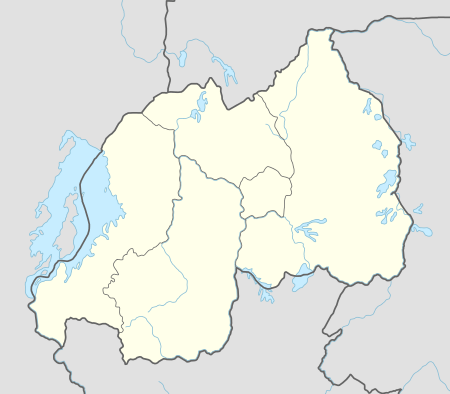Kibeho
| Kibeho | |
|---|---|
 Kibeho Location in Rwanda | |
| Coordinates: 2°38′S 29°33′E / 2.633°S 29.550°E | |
| Country |
|
| Admin. Province | Southern Province |
| Area | |
| • Total | 79 km2 (31 sq mi) |
| Population (2012 census) | |
| • Total | 21,456 |
| • Density | 270/km2 (700/sq mi) |
Kibeho is a small town in south Rwanda, which became known outside of that country because of reported apparitions of the Blessed Virgin Mary and Jesus Christ occurring between 1981 and 1989. It is also known for the Kibeho Massacre, in April 1995, where several thousand internally displaced people were killed by the Rwandan Patriotic Army.
History
Visions
The Blessed Virgin Mary and Jesus Christ reportedly appeared to a 19-, 20-, and 21-year-old in Kibeho in 1981, as Our Lady of Kibeho. These visions were accompanied by intense reactions: crying, tremors, and comas. [1]
On 19 August 1982, those who saw the visions reported gruesome sights (rivers of blood, sliced heads, etc.) which some today regard as an ominous foreshadowing of the Rwandan Genocide of 1994, and particularly in that specific location in 1995.
Catholic Bishop Augustin Misago of Gikongoro, Rwanda approved public devotion linked to the apparitions on 15 August 1988 and declared their authenticity on 29 June 2001. In his declaration, the bishop singled out visions of Mary by three original visionaries as worthy of belief, but declined to declare as worthy of belief purported visions of Jesus due to "disquieting personal situations" developed by the alleged visionaries in that case, which alleged visionaries are other than the three original visionaries of Mary.[2]
Kibeho Massacre
After the 1994 genocide, Kibeho was the site of an internally displaced person (IDP) refugee camp, with many of the Hutu refugees suspected of having participated in the genocide. The camp was the largest in Rwanda, spreading 9 square kilometers and containing between 80,000 and 100,000 people.[3] In mid - April 1995, elements of the Tutsi - led Rwandan Patriotic Army (RPA), announced they would close the camp, with the aim of forcibly separating known Génocidaires from those who would be sent home. As the camp was closed, tensions mounted and RPA troops opened fire on some of the remaining refugees. Australian and Zambian troops of the United Nations Assistance Mission for Rwanda (UNAMIR) and staff from International Aid Agencies witnessed the massacre.
Many of these were killed in the same school in which the apparitions had occurred; one of the children who reported the vision was even one of the victims. The local bishop recognized officially on 29 June 2001 three cases as authentic. The church Notre-Dame des Douleurs (Our Lady of Sorrows) was built in Kibeho, supported by Pallottines.
See also
Notes
- ↑ Tardif, Thérèse. "To avoid a horrible war conversion, prayer, penance, fasting. Messages of Our Lady of Sorrows in Kibeho, Rwanda". Pilgrims of St. Michael. Retrieved 2009-04-04.
- ↑ Bishop Augustin Misago of Gikongoro (2001-07-31). "Judgment on the apparitions of Kibeho". EWTN. Retrieved 2009-04-04.
- ↑ "Connor, John: Bravery Under Fire". Wartime, Issue 39. Australian War Memorial. Retrieved 2008-09-25.
External links
| Wikivoyage has a travel guide for Kibeho. |
- Documentary on the Kibeho apparitions
- Website about the Kibeho apparitions
- Video of the Kibeho apparitions
- Book about Kibeho written by Genocide Survivor and NY Times bestselling author Immaculée Ilibagiza
- Article about Kibeho
- http://sunday.ninemsn.com.au/sunday/cover_stories/article_1869.asp?s=1
- 25th anniversary of apparitions to be celebrated
- Witness to Genocide -- A Personal Account of the 1995 Kibeho Massacre
- Apparitions approved by the Catholic Church
- EWTN report of the Official Judgement of the Catholic Church on the Kibeho Apparitions
- Article about the bishop's trial
- Video 2 of the Kibeho apparitions
- Video 3 of the Kibeho apparitions
- Kibeho Sanctuary official web page
Coordinates: 2°38′S 29°33′E / 2.633°S 29.550°E